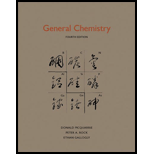
Concept explainers
a)
Interpretation:
Balanced chemical equation for the following reaction has to be determined.
Concept Introduction:
The reaction that has equal number of atoms of different elements in reactant as well as in product side is called balanced
a)
Explanation of Solution
The steps to balance a chemical reaction are as follows:
Step 1: Write the unbalanced equation.
Step 2:Then write the number of atoms of all elements that are present in chemical reaction in the reactant side and product side.
i) On reactant side,
Number of sodium atoms is 1.
Number of aluminum atom is 2.
Number of oxygen atoms is 4.
Number of fluorine atom is 1.
Number of hydrogen atoms is 2.
ii) On product side,
Number of sodium atoms is 3.
Number of aluminum atom is 1.
Number of oxygen atoms is 1.
Number of fluorine atom is 6.
Number of hydrogen atoms is 2.
Step 3: Balance the number of other atoms of elements except carbon, oxygen, and hydrogen by multiplying with some number on any side. All atoms are unbalanced on both sides. First, balance the number of aluminum and sodium atom multiply
Step 4: After this, the number of atoms of hydrogen atom followed by oxygen atoms. The hydrogen and oxygen atoms are unbalanced on both sides, multiply
Step 5: Finally, check the number of atoms of each element on both sides. If the number is same then chemical equation is balanced. The balanced chemical equation is,
b)
Interpretation:
Mass of
Concept Introduction:
Mole is S.I. unit. The number of moles is calculated as ratio of mass of compound to molar mass of compound.
Molar mass is sum of the total mass in grams of all atoms that make up mole of particular molecule that is mass of 1 mole of compound. The S.I unit is
The expression to relate number of moles, mass and molar mass of compound is as follows:
Mass percent is calculated by the mass of the element divided by the mass of compound and multiplied by 100.
The formula to calculate mass percentage of substance is as follows:
For more than one quantity of reactants in a reaction, the reactant that is completely consumed and controls the amount of product synthesized is called limiting reactant. The other reactants are called excess reactants. Also, the limiting reactant is completely consumed the initial mass of limiting reactant is used to calculate mass of product.
b)
Answer to Problem 11.53P
Mass of
Explanation of Solution
The reaction is as follows:
The formula to calculate moles of
Substitute
The formula to calculate moles of
Substitute
The formula to calculate moles of
Substitute
To find the limiting reactant, divide the number of moles of each reactant by their stoichiometric coefficients.
i) The stoichiometric coefficient of
ii)The stoichiometric coefficient of
iii)The stoichiometric coefficient of
The number of moles of
The reaction is as follows:
According to stoichiometry of reaction, 1 mole of
The formula to calculate number of moles of
Substitute
The formula to calculate mass of
Substitute
c)
Interpretation:
Mass of excess reactants produced from following reaction has to be determined.
Concept Introduction:
Refer to part (b).
c)
Answer to Problem 11.53P
Mass of excess
Explanation of Solution
The number of moles of
According to stoichiometry of reaction, 12 moles of
The formula to calculate number of moles of
Substitute
The formula to calculate excess mole of
Substitute,
The formula to calculate mass of
Substitute
According to stoichiometry of reaction, 1 mole of
The formula to calculate number of moles of
Substitute
Excess mole of
Substitute,
The formula to calculate mass of
Substitute
Want to see more full solutions like this?
Chapter 11 Solutions
General Chemistry
 ChemistryChemistryISBN:9781305957404Author:Steven S. Zumdahl, Susan A. Zumdahl, Donald J. DeCostePublisher:Cengage Learning
ChemistryChemistryISBN:9781305957404Author:Steven S. Zumdahl, Susan A. Zumdahl, Donald J. DeCostePublisher:Cengage Learning ChemistryChemistryISBN:9781259911156Author:Raymond Chang Dr., Jason Overby ProfessorPublisher:McGraw-Hill Education
ChemistryChemistryISBN:9781259911156Author:Raymond Chang Dr., Jason Overby ProfessorPublisher:McGraw-Hill Education Principles of Instrumental AnalysisChemistryISBN:9781305577213Author:Douglas A. Skoog, F. James Holler, Stanley R. CrouchPublisher:Cengage Learning
Principles of Instrumental AnalysisChemistryISBN:9781305577213Author:Douglas A. Skoog, F. James Holler, Stanley R. CrouchPublisher:Cengage Learning Organic ChemistryChemistryISBN:9780078021558Author:Janice Gorzynski Smith Dr.Publisher:McGraw-Hill Education
Organic ChemistryChemistryISBN:9780078021558Author:Janice Gorzynski Smith Dr.Publisher:McGraw-Hill Education Chemistry: Principles and ReactionsChemistryISBN:9781305079373Author:William L. Masterton, Cecile N. HurleyPublisher:Cengage Learning
Chemistry: Principles and ReactionsChemistryISBN:9781305079373Author:William L. Masterton, Cecile N. HurleyPublisher:Cengage Learning Elementary Principles of Chemical Processes, Bind...ChemistryISBN:9781118431221Author:Richard M. Felder, Ronald W. Rousseau, Lisa G. BullardPublisher:WILEY
Elementary Principles of Chemical Processes, Bind...ChemistryISBN:9781118431221Author:Richard M. Felder, Ronald W. Rousseau, Lisa G. BullardPublisher:WILEY





